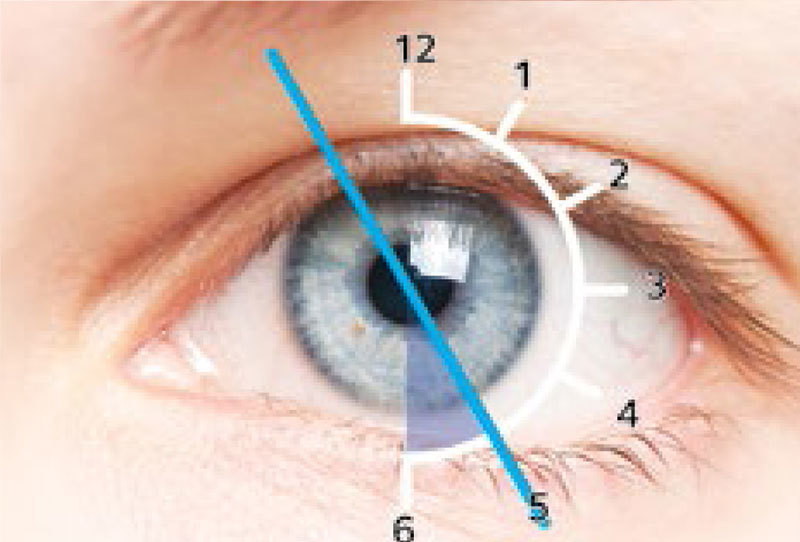Biofinity® toric lens fitting guidelines
Step 1
Start with a new refraction. Select initial trial lens power according to the spectacle to contact lens power conversion table. Select the trial lens axis closest to the spectacle axis. Biofinity toric lens offers round-the-clock axes in 10 degree steps.
Step 2
Insert the trial lens into the patient’s eye. Wait 10 minutes for the contact lens to settle on the eye before evaluating the contact lens fit and visual acuity.
Step 3
Evaluate the contact lens fitting for:
- Corneal coverage and centration of the contact lens.
- Contact lens movement upon blinking in primary or upgaze position.
- Toric lens marking and determine the direction and angle of lens rotation.
Step 4
Evaluate visual acuity:
- Perform spherical over refraction.
- If visual acuity improves, use a new trial lens with adjusted sphere power or dispense the contact lenses with the new power.
- If there is any lens rotation, visual acuity might not be improved by adding plus or minus sphere power.
Axis compensation is required for next trial lens selection or prescribing the final contact lens power (see LARS/CAAS method for axis compensation).
LARS/CAAS method for axis compensation
LARS and CAAS are acronyms for Left Add, Right Subtract and Clockwise Add, Anti-clockwise Subtract respectively. They basically mean the same thing.
The LARS/CAAS method is a way to determine the contact lens axis for next trial lens or final lens prescription, if a toric contact lens is found to rotate on the eye.
If the contact lens has rotated on the eye to the left or clockwise, then the angle of the lens rotation should be added to the existing axis for next trial lens or the final prescription.
If the contact lens on the eye has rotated to the right or anti-clockwise, the angle of the lens rotation should be subtracted from the existing axis for next trial lens or the final prescription.
Examples

Figure 1
In Figure 1, the contact lens has rotated 20° to the left (clockwise). By employing the LARS/CAAS method, the angle of rotation, i.e. 20° nasal, should be added to the existing axis for next trial lens or the final prescription.
If the lens power is -1.00 / -0.75 X 180
The next trial lens power or the final prescription should be:
= -1.00 / -0.75 X (180 + 20)
= -1.00 / -0.75 X (0* + 20)
= -1.00 / -0.75 X 20
*axis 180 is equivalent to axis 0

Figure 2
In Figure 2, the lens has rotated 30° to the right (anti-clockwise). By employing the LARS/CAAS method, the angle of rotation, i.e. 30° temporal, should be subtracted from the existing axis for next trial lens or the final prescription.
If the lens power is -1.00 / -0.75 X 180
The next trial lens power or the final prescription should be:
= -1.00 / -0.75 X (180 - 30)
= -1.00 / -0.75 X 150







